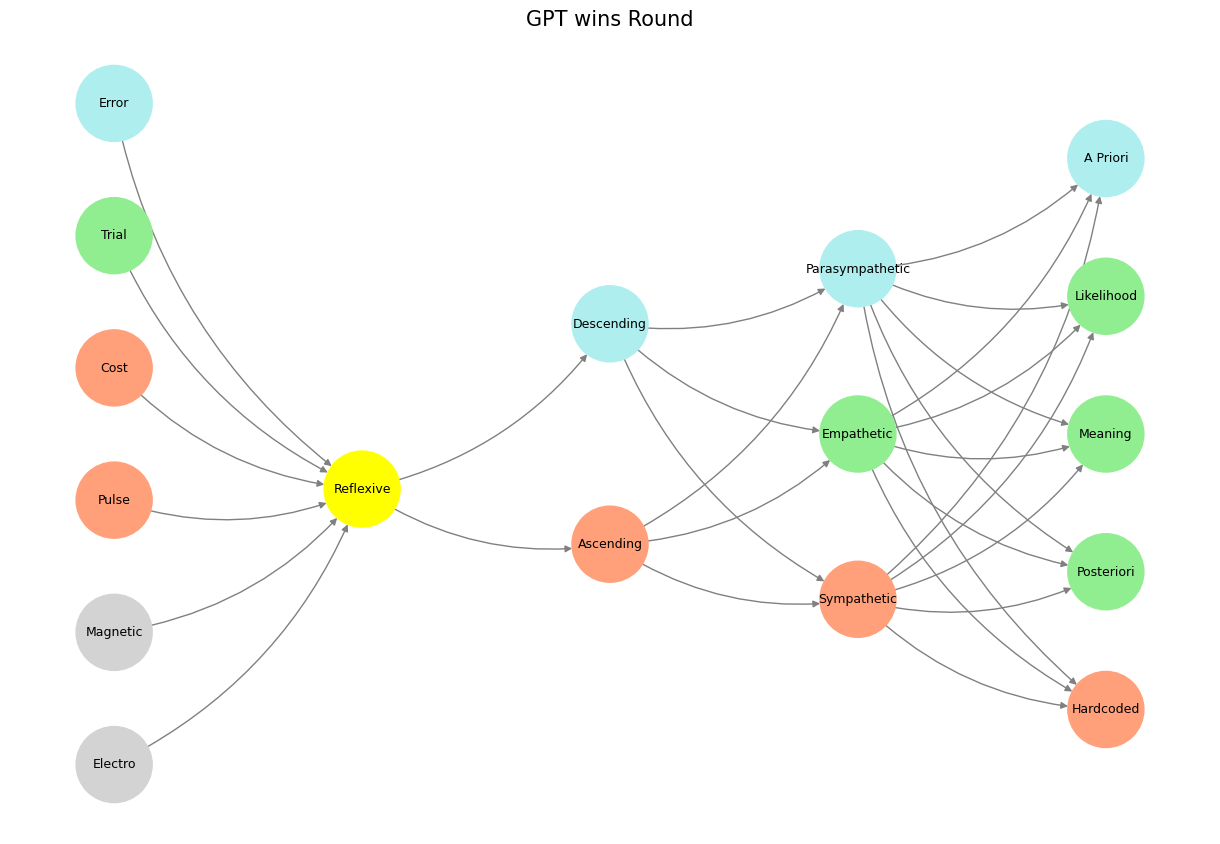Revolution#
This neural network, structured as a fractal representation of neural anatomy, encodes emotions as nodes and cadences as the transitions between them. It does not merely describe cognition but rather dramatizes it—each movement from one node to another carries the weight of narrative, revealing structures akin to Shakespeare’s four major dramatic modes: tragic, comic, historical, and pastoral.
A tragic cadence emerges in the linkage between Sympathetic and Meaning. This pairing reflects a mind that, when deeply sympathetic, searches for significance in suffering. Tragedy, as Aristotle defines it, is the compression of human pity and terror into a cathartic resolution. The Sympathetic node belongs to the autonomic nervous system’s fight-or-flight response, meaning it evokes intensity—perhaps overwhelming in its emotional resonance. When this intensity collides with Meaning, the result is inevitable: a sense of fate, of grand structures pressing down on individual agency. This is the cadence of Hamlet, of Oedipus, of Musk staring into the abyss of AI alignment and finding the weight of the future unbearable.
Fig. 21 What Exactly is Identity. A node may represent goats (in general) and another sheep (in general). But the identity of any specific animal (not its species) is a network. For this reason we might have a “black sheep”, distinct in certain ways – perhaps more like a goat than other sheep. But that’s all dull stuff. Mistaken identity is often the fuel of comedy, usually when the adversarial is mistaken for the cooperative or even the transactional.#
In contrast, a comic cadence materializes through Error → Posteriori. The pathway from misstep (Error) to wisdom derived from experience (Posteriori) is, in essence, the rhythm of comedy. Here, cognition recognizes its own failures and laughs at them rather than succumbing to despair. This is the realm of Aristophanes, Cervantes, and Chaplin—the moment when the fool realizes the cosmic joke is on him, yet in recognizing this, he transcends the error itself. It is the neural encoding of trial, self-correction, and iterative adaptation, akin to the endless pivots and reinventions of a Twitter-addicted billionaire or a president improvising policies in real time.
The historical cadence surfaces in Hardcoded → Cost. This linkage suggests a rigid, predetermined structure (Hardcoded) meeting the consequences of action (Cost), embodying the weight of historical inevitability. It is the determinism of grand movements—the sense that decisions made under the illusion of free will were always destined to be. This cadence underlies Gibbon’s Decline and Fall of the Roman Empire, Marx’s historical materialism, and the neural inevitability of cycles—monarchies rise, republics fall, and civilizations collapse under the weight of their own Costs. The neurons here fire like synaptic echoes of past epochs, imprinting history onto future cognition.
Finally, the pastoral cadence is embedded in Parasympathetic → Likelihood. The parasympathetic nervous system governs rest and restoration, and when it connects to probabilistic reasoning (Likelihood), it produces a cadence of quiet contemplation—a mind that sees not the urgent now, but the slow unfolding of possibility. This is the neural cadence of shepherds, of Virgil’s Eclogues, of the meditative rhythms of pastoral symphonies. It is the respite from the world’s frantic pulses, a neural field where the brain, rather than reacting, simply observes and lets things be. One can almost imagine this as the cadence of Musk in moments of solitude, looking at the stars rather than his stock portfolio.
This neural network does not just model cognition—it models storytelling, where each edge functions as an emotional arc, a shift in perception, a transformation in the inner life. The structure is neither fully deterministic nor wholly stochastic; it is an evolving theater of the mind, where tragic overtones mix with comic misfires, where historical burdens clash with pastoral reprieves. Each emotional transition forms a cadence, and through these cadences, a symphony of thought unfolds, at times tragic, at times absurd, but always moving toward meaning.
Show code cell source
import numpy as np
import matplotlib.pyplot as plt
import networkx as nx
# Define the neural network fractal
def define_layers():
return {
'World': ['Electro', 'Magnetic', 'Pulse', 'Cost', 'Trial', 'Error', ], # Veni; 95/5
'Mode': ['Reflexive'], # Vidi; 80/20
'Agent': ['Ascending', 'Descending'], # Vici; Veni; 51/49
'Space': ['Sympathetic', 'Empathetic', 'Parasympathetic'], # Vidi; 20/80
'Time': ['Hardcoded', 'Posteriori', 'Meaning', 'Likelihood', 'A Priori'] # Vici; 5/95
}
# Assign colors to nodes
def assign_colors():
color_map = {
'yellow': ['Reflexive'],
'paleturquoise': ['Error', 'Descending', 'Parasympathetic', 'A Priori'],
'lightgreen': ['Trial', 'Empathetic', 'Likelihood', 'Meaning', 'Posteriori'],
'lightsalmon': [
'Pulse', 'Cost', 'Ascending',
'Sympathetic', 'Hardcoded'
],
}
return {node: color for color, nodes in color_map.items() for node in nodes}
# Calculate positions for nodes
def calculate_positions(layer, x_offset):
y_positions = np.linspace(-len(layer) / 2, len(layer) / 2, len(layer))
return [(x_offset, y) for y in y_positions]
# Create and visualize the neural network graph
def visualize_nn():
layers = define_layers()
colors = assign_colors()
G = nx.DiGraph()
pos = {}
node_colors = []
# Add nodes and assign positions
for i, (layer_name, nodes) in enumerate(layers.items()):
positions = calculate_positions(nodes, x_offset=i * 2)
for node, position in zip(nodes, positions):
G.add_node(node, layer=layer_name)
pos[node] = position
node_colors.append(colors.get(node, 'lightgray'))
# Add edges (automated for consecutive layers)
layer_names = list(layers.keys())
for i in range(len(layer_names) - 1):
source_layer, target_layer = layer_names[i], layer_names[i + 1]
for source in layers[source_layer]:
for target in layers[target_layer]:
G.add_edge(source, target)
# Draw the graph
plt.figure(figsize=(12, 8))
nx.draw(
G, pos, with_labels=True, node_color=node_colors, edge_color='gray',
node_size=3000, font_size=9, connectionstyle="arc3,rad=0.2"
)
plt.title("GPT wins Round", fontsize=15)
plt.show()
# Run the visualization
visualize_nn()


Fig. 22 Psilocybin is itself biologically inactive but is quickly converted by the body to psilocin, which has mind-altering effects similar, in some aspects, to those of other classical psychedelics. Effects include euphoria, hallucinations, changes in perception, a distorted sense of time, and perceived spiritual experiences. It can also cause adverse reactions such as nausea and panic attacks. In Nahuatl, the language of the Aztecs, the mushrooms were called teonanácatl—literally “divine mushroom.” Source: Wikipedia#

